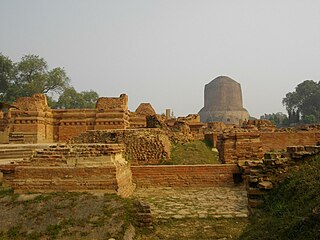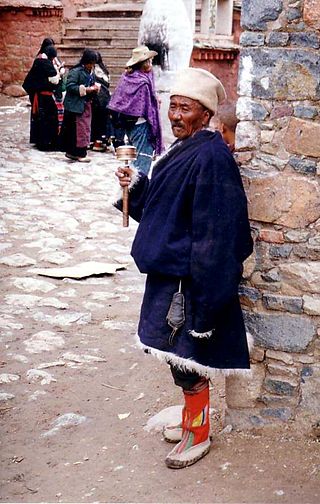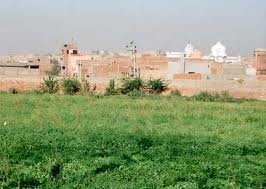
Sarnath is a place located 10 kilometres northeast of Varanasi, near the confluence of the Ganges and the Varuna rivers in Uttar Pradesh, India.

Jagadhri is a city and a municipal council in the Yamunanagar district of the Indian state of Haryana. This town lies adjacent to the city of Yamunanagar. The demarcation line between the two is difficult to discern. Jagadhri is around 90 km away from Chandigarh, the capital city of Haryana state. This town is known for the cluster of brass and copper industries. Jagadhri is known as the "Brass City" of India.

Ramateertham is a village panchayat in Nellimarla mandal of Vizianagaram district in Andhra Pradesh in India. It is about 12 km from Vizianagaram city. It is a famous Pilgrimage and also Ancient Historical Site since 3rd Century BCE. There is a post office at Ramateertham. The PIN code is 535218.
Sanghol is a historical village located in Fatehgarh Sahib District of Punjab, India predating to Harrapan civilisation. It is also known as Uchha Pind Sanghol. It is about 40 km from Chandigarh on the way to Ludhiana and approximately 10 km from Dholewal. This place holds a special position on the archaeological atlas of India. Excavations at the site have yielded coins and seals related to Toramana and Mihirakula belonging to central Asia. A Buddhist stupa was excavated in 1968, but in February 1985 a rich treasure of 117 beautiful carved stone slabs, which includes 69 pillars, 35 crossbars, figures and figurines, was excavated by the experts of the Directorate of Archaeology, Punjab. Scholars have explained them as Kushan sculptures of the Mathura school of the 1st and 2nd centuries AD. These treasures have since been displayed for art lovers and historians in Sanghol Museum. Many of the art pieces from this museum often go on display as special exhibits at various museums around the world.
Buria is a small town and earlier was a municipal committee now the part of Yamunanagr Nagar nigam situated on the banks of the Western Yamuna Canal approximately 3 kilometres (1.9 mi) from the city of Jagadhri and 8 km from Jagadhri railway station.
Chhachhrauli is a tehsil and Gram Panchayat town consisting of 20 wards in Yamuna Nagar district in the state of Haryana, India. It is 11 km north-east of Jagadhari. Chachhraulli is often known as "Cherapunjii of Haryana" as it receives the most rain in the whole of Haryana . It was a municipal committee until 1998. Before independence in 1947, it was the capital of the princely state of Kalsia. The origin of word Chhachhrauli is believed to be "Sat Sherawali" due to a temple located near bus terminus.

The most important places in Buddhism are located in the Indo-Gangetic Plain of northern India and southern Nepal, in the area between New Delhi and Rajgir. This is the area where Gautama Buddha lived and taught, and the main sites connected to his life are now important places of pilgrimage for both Buddhists and Hindus. However, many countries that are or were predominantly Buddhist have shrines and places which can be visited as a pilgrimage.

In religion and spirituality, a pilgrimage is a long journey or search of great moral significance. Sometimes, it is a journey to a sacred place or to a shrine of importance to a person's beliefs and faith. Members of every major religion participate in pilgrimages. A person who makes such a journey is called a pilgrim.

Haryana is a state in India. The state houses several sites from the Indus Valley Civilization, which was a cradle of civilization. In the Mahabharata, Haryana is mentioned as Bahudanayak Region.
Bihar (Hindi: Bihar,, [Bihar] in eastern India is one of the oldest inhabited places in the world with a history going back 3000 years. The rich culture and heritage of Bihar is evident from the innumerable ancient monuments that are dotted all over the state. Bihar is home to many tourist attractions and is visited by large numbers of tourists from all over the world. Around total 6 million tourists visit Bihar every year.
Ramagrama stupa is a stupa located in Ramgram Municipality, in the Parasi District of Nepal. This Buddhist pilgrimage site containing relics of Gautama Buddha was constructed between the Mauryan and Gupta periods, according to research by Nepal’s Department of Archaeology.

Kushinagar is a town in the Kushinagar district in Uttar Pradesh, India. It is an important and popular Buddhist pilgrimage site, where Buddhists believe Gautama Buddha attained Parinirvana.

Agroha, locally known as Ther, is an archaeological site located in Agroha, in the Hisar district of India.

Kapal Mochan is an ancient place of pilgrimage for both Hindus and Sikhs, 17 km north-east of Yamunanagar city-Jagadhari town, on the Bilaspur road in Yamunanagar district, Haryana, India. It is also called Gopal Mochan and Somsar Mochan. As per Legend, Brāhmanahatya i.e. killing of Brahmin is considered as a major sin, but one who kills a Brahmin and bath here, his Brāhmanahatya sins will be washed. Nearby Bilaspur, Haryana in Yamuna Nagar District which takes its name from the corrupted form of "Vyas Puri", was the ashram of Ved Vyasa rishi where he wrote the Mahabharta on the banks of Sarasvati river near Adi Badri where Sarasvati river leaves Himalayas and enters the plains.
Adi Badri, also Sri Sarasvati Udgam Tirath, is a tourist site of archaeological, religious and ecological significance in a forest area in the foothills of the Sivalik Hills in Bhabar area, situated in northern part of Yamunanagar district, of the north Indian state of Haryana. There are remains of many Buddhist stupas and monasteries, which are about 1500–2000 years old, and there is also a group of Hindu temples from the 9th century. Based on the multiple archaeological excavations undertaken here, archaeologists have sent the proposal to Archaeological Survey of India (ASI) to include this site in the list of protected heritage site. Several popular annual festivals are held here, including the five day long National Saraswati Festival in January, Adi Badri Akha Teej Mela in Vaisakh around April–May, week-long Adi Badri-Kapal Mochan Kartik Purnima religious mela around November.

The 48 kos parikrama is a parikrama of various Mahabharata-related and other Vedic-era tirthas around the holy city of Kurukshetra in the state of Haryana, India.

Srughna, also spelt Shrughna in Sanskrit, or Sughna, Sughana or Sugh in the spoken form, was an ancient city or kingdom of India frequently referred to in early and medieval texts. It was visited by Chinese traveller, Xuanzang in the 7th century and was reported to be in ruins even then although the foundations still remained. Xuanzang described the kingdom as extending from the mountains to the north, to the Ganges river to the East, and with the Yamuna river flowing through it. He described the capital city on the west bank of the Yamuna as possessing a large Buddhist vihara and a grand stupa dating to the time of the Mauryan emperor, Ashoka. Srughna is identified with the Sugh Ancient Mound located in the village of Amadalpur Dayalgarh, in the Yamunanagar district of Haryana state of India. To this day, the ancient Chaneti Buddhist Stupa, probably dating to the Mauryan period, stands in the area, about 3 kilometres (1.9 mi) northwest of Sugh.
Amadalpur village is a part of tehsil Jagadhri of district Yamunanagar, situated in Haryana, India.

Chaneti Buddhist Stupa is a 3rd century BC monument protected by the Government of India. The stupa is located in the Yamunanagar district of Haryana, three kilometers east of Jagadhri, and about three kilometers northwest of the archaeological site Sugh. The stupa has been referred by traveller Hiuen Tsang.

Ballal Dhipi is a historic archeological site on the eastern flood plain of the Hooghly in Nadia, West Bengal, a few kilometres east of Nabadwip. The remains date back to the 12th century AD and earlier. A 30-ft structure of solid terracotta bricks is spread over an area of 1,300 sq ft. with a floor made of lime and sand. It is named after Ballala Sena (1160-1179) of the Sena dynasty.















